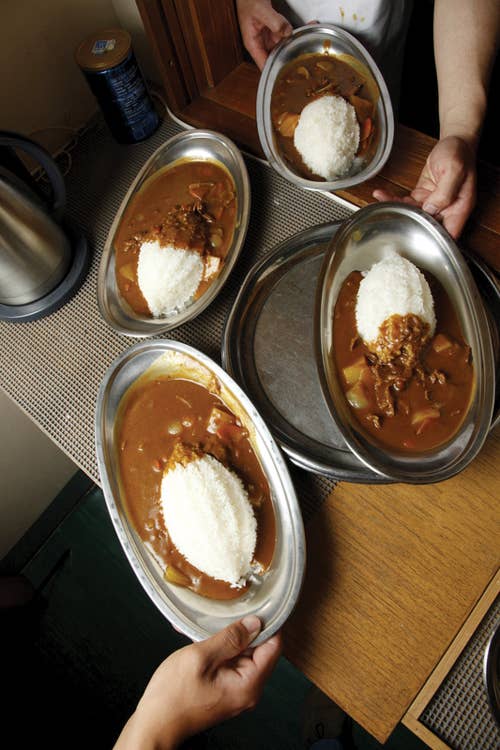
Friday Night Special
Aboard the ships of the Japan Maritime Self-Defense Force, curry is a delicious tradition
Tender chunks of pork and vegetables simmer in a thick umber roux. It's Friday night and almost suppertime onboard the battleship Hachijo, a naval patrol vessel docked in the port of Yokosuka, an hour south of Tokyo. Ketchup, curry, honey, garlic, cayenne, and coffee are added next—a mélange of seasonings that seems strange at first but reduces harmoniously in the pot. Once all of the ingredients are incorporated, the stew is ladled into trays. A heap of steaming white rice provides a signature complement, along with a side salad and a chilled glass of milk. Hungry sailors, hundreds of them, are the last to arrive. It is time for the crew to indulge in a cherished Japanese navy tradition: battleship curry.
In Japan, curry is a versatile favorite all over the island. The curried roux base, with chopped meats or fish, vegetables, tubers, and more or less spice to taste, may contain pickles, fruit, or even traces of chocolate to coax the complex sweet-savory flavor; the result is the ultimate plate of comfort food. Japanese curry is on the table at least once a week in the average household, but before it was a mainland mainstay, curry was a staple for men at sea: Japanese curry has its origins in the navy.
In 1853, when Commodore Matthew Perry's fleet initiated American relations with Japan, the U.S. Navy ruptured a 200-year-old bubble of sakoku—seclusion—forcing open a sheltered society. Prior to Western interruption, Japan had isolated itself from the rest of the world. Strict regulations limited foreign involvement, and, under the reigning Buddhist doctrine, meat consumption had been banned for centuries. Exposure to western products, customs, and men—men who seemed much healthier and stronger, and who did eat meat—caused the Japanese people to reevaluate their society and cuisine. By the time a British can of curry powder made its way across the ocean in the early 1870s, Japan had entered the Meiji period, an era of restoration and openness to the West, and was ready to embrace new dishes and ingredients.
The concept of curry sailed over to Japan on a British navy ship, but not in the luscious roux-based dish that the Japanese came to revere. Initially, the Japanese navy adopted British curry out of necessity, not luxury. Until this point in the late 19th century, plain rice and other grains presented the only meal available to Japanese seamen; fresh vegetables and fish had long since been reserved for the middle and upper classes at home. Barely sustained by rice alone, the Japanese navy suffered serious malnutrition. Cases of beriberi, caused by a lack of thiamine or vitamin B1, were rampant among crews. In 1872, in an effort to combat vitamin deficiency, the Yokosuka Naval Base was the first to offer British curry at mealtime: a soupier curried broth with beef and vegetables, served with bread. Introducing meat, vegetables, and whole grains to everyday Japanese navy fare provided much needed protein and thiamine.
In time, more than 50 navy galleys put curry on the menu, adapting the dish to Japanese tastes. Substituting rice for more traditional bread, adding more beef, and thickening the texture of curry with flour made the Japanese version, a most suitable dish at sea. The stickier roux adhered to rice and created much less of a mess on deck, and ingredients were cost-effective and delicious. Nutrient-rich curry became the primary means for a hearty, healthy diet, served every Friday to notify crew members of the correct day of the week.
Today sailors in the Japan Maritime Self-Defense Force still enjoy curry on Fridays—in fact, each ship has its own distinct version—and it is always eaten with a spoon, not chopsticks (a custom that points to the dish’s British origins). A salad with tomatoes and a hard-boiled egg traditionally completes the plate, with a glass of milk on the side. Happily, you don’t necessarily need to enlist in the navy to try the curries—all of the ships present their recipes at a curry festival in Tsuchiura each November.
For more information on the Tsuchiura Curry Festival, contact the Japanese National Tourism Organization (212/757-5640; japantravelinfo.com).
Keep Reading
Continue to Next Story










